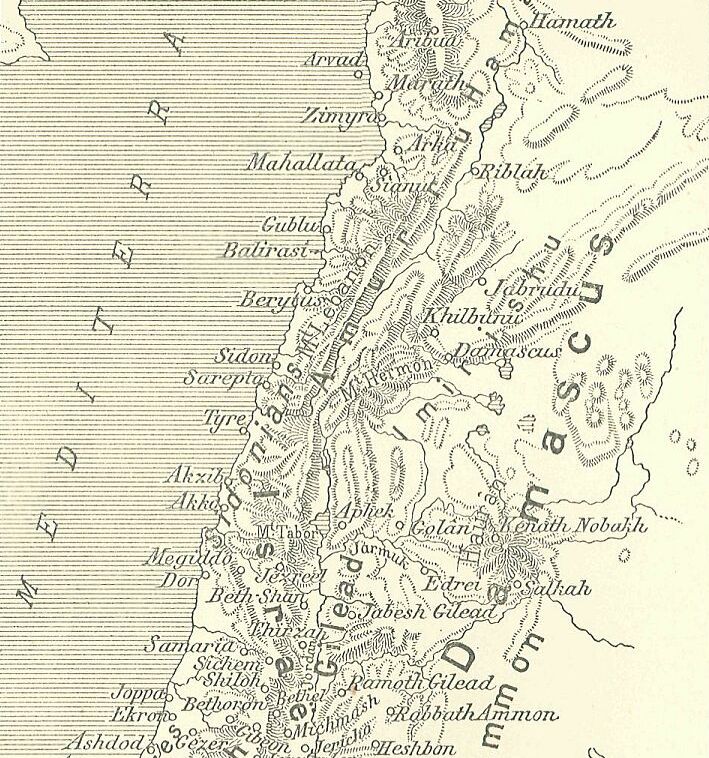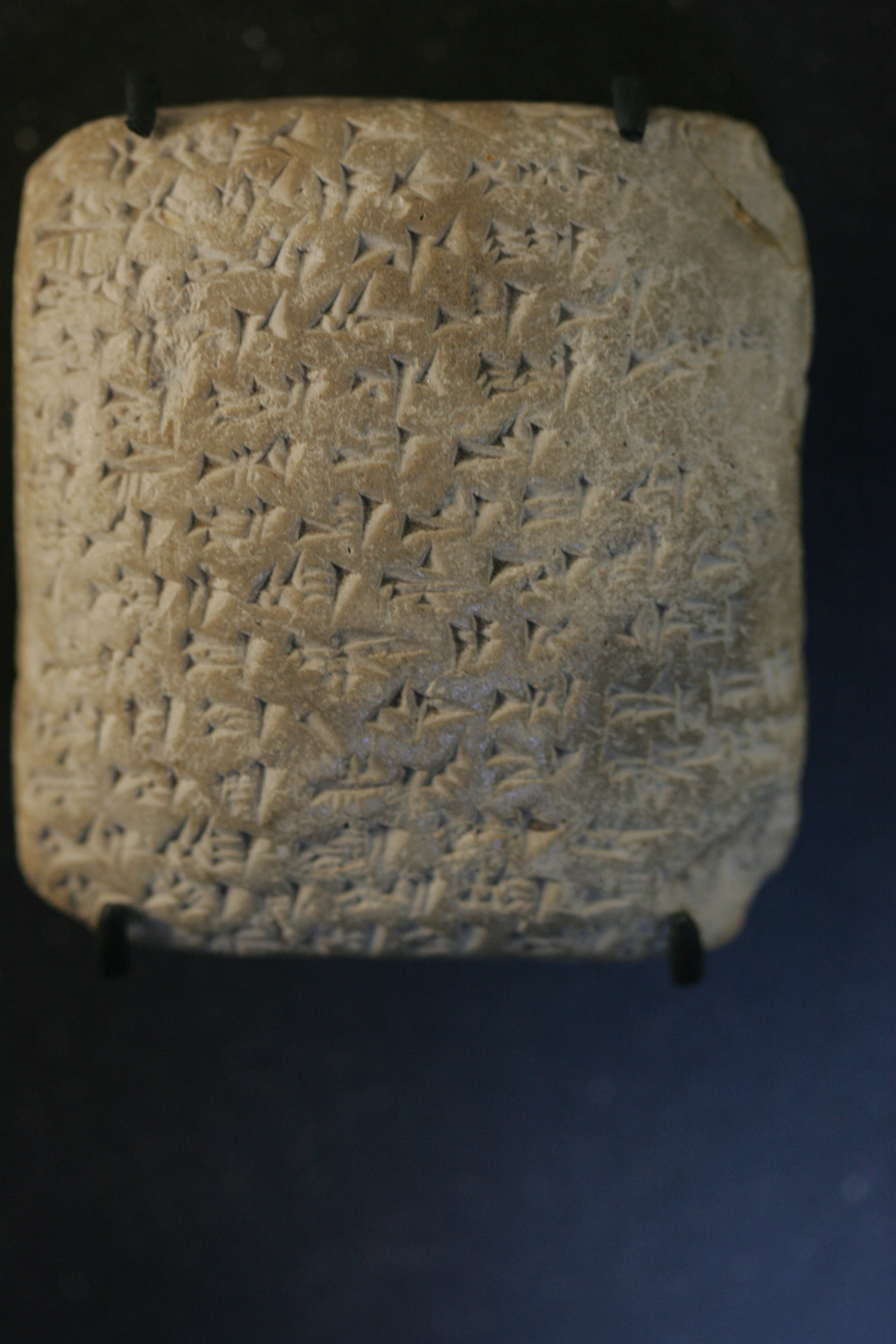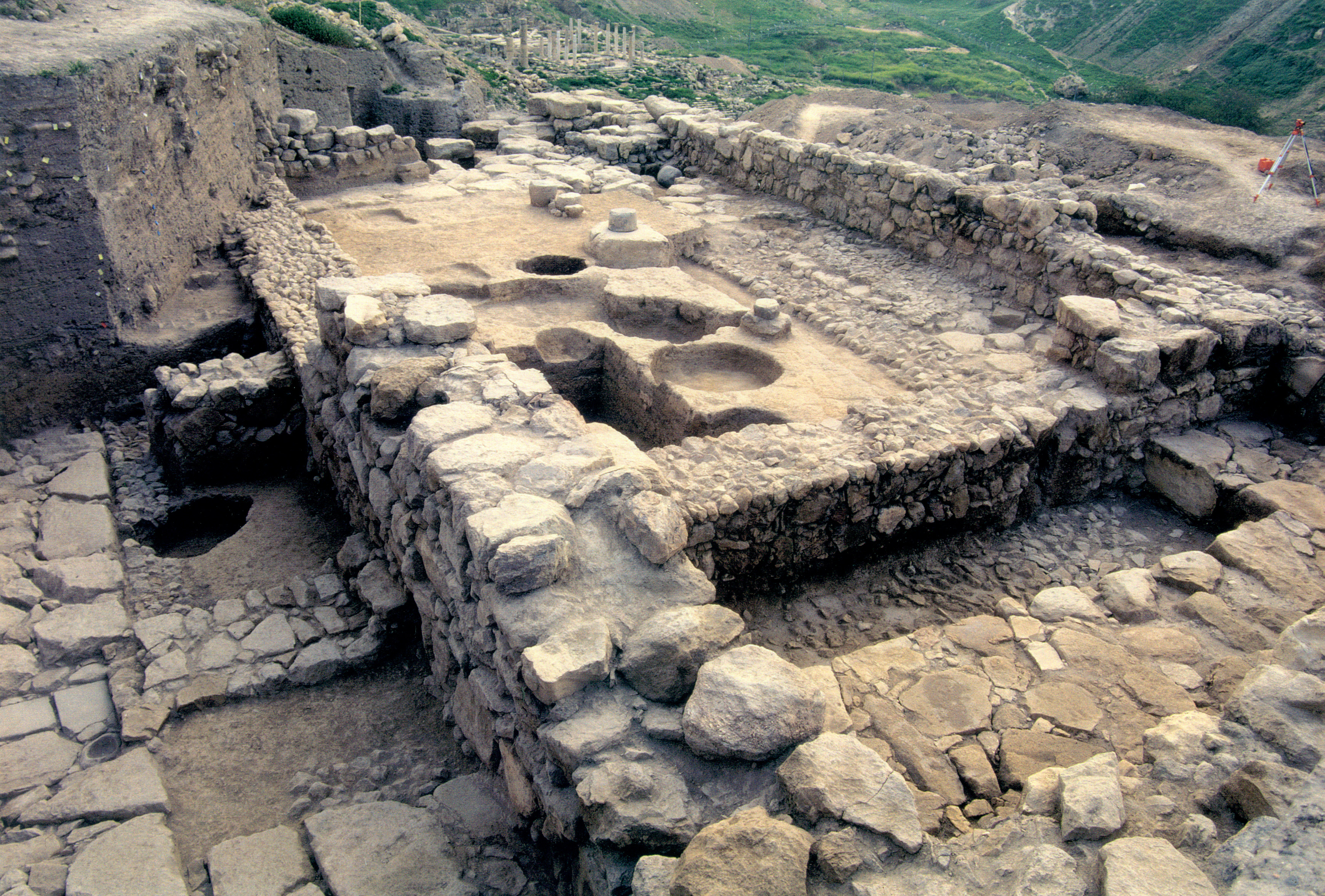|
Mutbaal
Mutbaal ( Akk. "man of Baal") was a Canaanite king of the Amarna Period. He is identified in the Amarna letters as a son of Labaya, the ruler of the hill country north of Jerusalem, including the territory in the vicinity of the city of Shachmu (biblical Shechem). Mutbaal may be the son whose association with the Habiru raiders Labaya denounced in EA 254. He ruled in Pella on the eastern side of the Jordan River. After his father's death at the hands of the citizens of Gina, Mutbaal and his brother continued their assaults on other Canaanite rulers and their holdings, employing Habiru mercenaries. Eventually Biryawaza of Damascus was ordered by the Egyptian court to take armed action against the sons of Labaya. (EA 250) List of Mutbaal's 2 letters to Pharaoh EA 255 Mutbaal letter no. 1 of 2, title: "No destination too far" Letter 255 by Mutbaal, about caravans, seems to imply that his location in western Jordan, (as "Mayor of Pihilu"-(modern Pella, Jordan)), was an important ... [...More Info...] [...Related Items...] OR: [Wikipedia] [Google] [Baidu] |
Labaya
Labaya (Labayu or Lib'ayu) was the ruler of Shechem and warlord in the central hill country of southern Canaan during the Amarna Period (c. 1350 BC). He lived contemporaneously with Pharaoh Akhenaten. Labaya is mentioned in several of the Amarna Letters (abbreviated "EA", for 'el Amarna'). He is the author of letters Amarna letter EA 252, EA 252–Amarna letter EA 254, 54. Labaya was active over the whole length of Samaria and slightly beyond, as he gave land to Habiru in the vicinity of Šakmu (Shechem) and he and his sons threatened such powerful towns as Jerusalem and Gazru (Gezer) to the south, and Megiddo (place), Megiddo to the north. Career The Amarna letters give an incomplete look at Labaya's career. In the first of Labaya's letters thus far discovered (EA 252), he defends himself to the Pharaoh against complaints of other city rulers about him, for example, the complaint that he has hired mercenaries from among the Habiru. Labaya further admitted to having invaded Ge ... [...More Info...] [...Related Items...] OR: [Wikipedia] [Google] [Baidu] |
Amarna Letter EA 256
Amarna letter EA 256, in short EA 256, catalogued under the title ''Oaths and Denials'', is one of a total of about 350 so-called Amarna letters, belonging to an official correspondence dating to the mid-14th century BC (about 1350 BC till 20–25 years later). The initial corpus of letters were found at Akhenaten's city Akhetaten, on the floor of the Bureau of Correspondence of Pharaoh; others were later found, adding to the body of letters. Description EA 256 is a square, mostly flat clay tablet letter written on both sides; it is also written on the bottom, top (=bottom of ''reverse'' side), and the last 3 lines are written on the left edge (obverse), where the start of lines on the obverse form a 'straight' margin. The reverse of the letter (see Rohl), has a list of towns in, or associated with the Golan Heights. The surface of the letter is rough (partially eroded?), or photos of the reverse especially, do not easily highlight the cuneiform characters. The topic of the le ... [...More Info...] [...Related Items...] OR: [Wikipedia] [Google] [Baidu] |
Pella, Jordan
Pella (, ) was an ancient city in what is now northwest Jordan, and contains ruins from the Neolithic, Chalcolithic, Bronze Age, Iron Age, Canaanite, Hellenistic and Islamic periods. It is located near a rich water source within the eastern foothills of the Jordan Valley, close to the modern village of Ṭabaqat Faḥl () some south of the Sea of Galilee (Lake Tiberias). The site is situated north of Amman: a drive of about two hours (due to the difficult terrain), and an hour southwest by car from Irbid, in the north of the country. Pella's ruins – predominantly temples, churches, and housing – have been partially excavated by teams of archaeologists; they attract thousands of tourists annually but especially in spring, during which time the area is awash with spring flowers. Tourism During the Roman period, Pella was a thriving city with evidence of urban planning, public spaces, and luxurious villas. The city’s location along ancient trade routes contributed to its pr ... [...More Info...] [...Related Items...] OR: [Wikipedia] [Google] [Baidu] |
Gina (Canaan)
Gina, mentioned in the Amarna Letters, was a town in ancient Canaan. The citizen Citizenship is a membership and allegiance to a sovereign state. Though citizenship is often conflated with nationality in today's English-speaking world, international law does not usually use the term ''citizenship'' to refer to nationality ...s of Gina were responsible for the death of Labaya. The town was later known as Beth-Hagan and was probably located roughly on the spot of the modern town of Jenin. History Amarna letter 250 records the only mention of Gina. It explains (in passing) the recent killing of Labaya and the resultant of dealing with his two sons. An excerpt of the mostly complete 60-line letter: See also * Mutbaal References Further reading * Moran, William L. ''The Amarna Letters.'' Johns Hopkins University Press, 1987, 1992. (softcover, ) Canaanite cities Amarna letters locations Former populated places in West Asia History of Jenin {{AncientNearEast-stub ... [...More Info...] [...Related Items...] OR: [Wikipedia] [Google] [Baidu] |
Akkadian Language
Akkadian ( ; )John Huehnergard & Christopher Woods, "Akkadian and Eblaite", ''The Cambridge Encyclopedia of the World's Ancient Languages''. Ed. Roger D. Woodard (2004, Cambridge) Pages 218–280 was an East Semitic language that is attested in ancient Mesopotamia ( Akkad, Assyria, Isin, Larsa, Babylonia and perhaps Dilmun) from the mid- third millennium BC until its gradual replacement in common use by Old Aramaic among Assyrians and Babylonians from the 8th century BC. Akkadian, which is the earliest documented Semitic language, is named after the city of Akkad, a major centre of Mesopotamian civilization during the Akkadian Empire (–2154 BC). It was written using the cuneiform script, originally used for Sumerian, but also used to write multiple languages in the region including Eblaite, Hurrian, Elamite, Old Persian and Hittite. The influence of Sumerian on Akkadian went beyond just the cuneiform script; owing to their close proximity, a lengthy span of con ... [...More Info...] [...Related Items...] OR: [Wikipedia] [Google] [Baidu] |
14th-century BC People
The 14th century lasted from 1 January 1301 (represented by the Roman numerals MCCCI) to 31 December 1400 (MCD). It is estimated that the century witnessed the death of more than 45 million lives from political and natural disasters in both Europe and the Mongol Empire. West Africa experienced economic growth and prosperity. In History of Europe, Europe, the Black Death claimed 25 million lives wiping out one third of the European population while the Kingdom of England and the Kingdom of France fought in the protracted Hundred Years' War after the death of King Charles IV of France led to a claim to the French throne by King Edward III of England. This period is considered the height of chivalry and marks the beginning of strong separate identities for both England and France as well as the foundation of the Italian Renaissance and the Ottoman Empire. In History of Asia, Asia, Tamerlane (Timur), established the Timurid Empire, history's third largest empire to have been ever ... [...More Info...] [...Related Items...] OR: [Wikipedia] [Google] [Baidu] |
Jonathan (1 Samuel)
Jonathan (Hebrew: ''Yəhōnāṯān'' or ''Yōnāṯān''; "YHWH has gifted") is a figure in the Book of Samuel of the Hebrew Bible. In the biblical narrative, he is the eldest son of King Saul of the Kingdom of Israel, and a close friend of David. He is described as having great strength and swiftness2 Samuel 1:23 and excelling in archery (2 Samuel 1:22 and slinging. Conflicts with Saul Jonathan first appears in the biblical narrative as the victor of Geba, a Philistine stronghold ( 1 Samuel 13), while in the following chapter he carries out a lone and secret attack on another Philistine garrison, demonstrating his "prowess and courage as a warrior."T. H. Jones, "Jonathan," in J. D. Douglas, (ed.), ''New Bible Dictionary'' (Grand Rapids: Eerdmans, 1965), 654. However, he eats honey without knowing that his father had said, "Cursed be any man who eats food before evening comes" (1 Samuel 14:24). When he learns of his father's oath, Jonathan disagrees with the wisdom of it, a ... [...More Info...] [...Related Items...] OR: [Wikipedia] [Google] [Baidu] |
King Saul
Saul (; , ; , ; ) was a monarch of ancient Israel and Judah and, according to the Hebrew Bible and Old Testament, the first king of the United Monarchy, a polity of uncertain historicity. His reign, traditionally placed in the late eleventh century BCE, according to the Bible, marked the transition of the Israelites from a scattered tribal society ruled by various judges to organized statehood. The historicity of Saul and the United Kingdom of Israel is not universally accepted, as what is known of both comes exclusively from the Hebrew Bible. According to the text, he was anointed as king of the Israelites by Samuel, and reigned from Gibeah. Saul is said to have committed suicide when he fell on his sword during a battle with the Philistines at Mount Gilboa, in which three of his sons were also killed. Saul's son Ish-bosheth succeeded him to the throne, reigning for only two years before being murdered by his own military leaders. Saul's son-in-law David the ... [...More Info...] [...Related Items...] OR: [Wikipedia] [Google] [Baidu] |
Israelite
Israelites were a Hebrew language, Hebrew-speaking ethnoreligious group, consisting of tribes that lived in Canaan during the Iron Age. Modern scholarship describes the Israelites as emerging from indigenous Canaanites, Canaanite populations and other peoples.Mark Smith in "The Early History of God: Yahweh and Other Deities of Ancient Israel" states "Despite the long regnant model that the Canaanites and Israelites were people of fundamentally different culture, archaeological data now casts doubt on this view. The material culture of the region exhibits numerous common points between Israelites and Canaanites in the Iron I period (c. 1200–1000 BCE). The record would suggest that the Israelite culture largely overlapped with and derived from Canaanite culture ... In short, Israelite culture was largely Canaanite in nature. Given the information available, one cannot maintain a radical cultural separation between Canaanites and Israelites for the Iron I period." (pp. ... [...More Info...] [...Related Items...] OR: [Wikipedia] [Google] [Baidu] |
Ishbaal
Ish-bosheth (, "man of shame"), also called Eshbaal (, ; alternatively spelled Ishbaal, "man of Baal") was, according to the Hebrew Bible, the second monarch of the Kingdom of Israel. After the death of his father, Saul, Ish-bosheth ascended to the throne and reigned for two years. During his reign, Ish-bosheth engaged in a protracted conflict with David, who had been anointed as Saul's successor by the prophet Samuel. This rivalry between the two leaders shaped the political landscape of the kingdom at the time. The Hebrew Bible recounts that Ish-bosheth's reign was marked by war with David's forces, as both factions vied for control and legitimacy. According to biblical accounts, he was killed by two of his own army captains, Baanah and Rechab, who believed that assassinating Ish-bosheth would earn them favour with David. This act not only brought a premature conclusion to Ish-bosheth's rule but also played a significant role in the subsequent unification of the kingdom under ... [...More Info...] [...Related Items...] OR: [Wikipedia] [Google] [Baidu] |
David Rohl
The New Chronology is an alternative chronology of the ancient Near East developed by English Egyptologist David Rohl and other researchers beginning with ''A Test of Time: The Bible - from Myth to History'' in 1995. It contradicts mainstream Egyptology by proposing a major revision of the established Egyptian chronology, in particular by re-dating Egyptian kings of the Nineteenth through Twenty-fifth Dynasties, bringing forward conventional dating by up to 350 years. Rohl asserts that the New Chronology allows him to identify some of the characters in the Hebrew Bible with people whose names appear in archaeological finds. The New Chronology, one of several proposed radical revisions of the conventional chronology, has not been accepted in academic Egyptology, where the conventional chronology or small variations of it remains standard. Amélie Kuhrt, head of Ancient Near Eastern History at University College London, in one of the standard reference works of the discipline, ... [...More Info...] [...Related Items...] OR: [Wikipedia] [Google] [Baidu] |
Joab
Joab (; ), the son of Zeruiah, was the nephew of King David and the commander of his army according to the Hebrew Bible. Name The name Joab is, like many other Hebrew names, theophoric—derived from Yahweh (), the name of the God of Israel, and the Hebrew word "father" (). It therefore means "Yahweh sthe Father". Life Joab was the son of Zeruiah, a sister of king David (1 Chronicles 2:15–16). According to Josephus ( ''Antiquities'' VII, 1, 3) his father was called Suri.Flavius Josephus, ''Antiquities of the Jews''Book VII, Chapter 1, 3 Joab had two brothers, Abishai and Asahel. Asahel was killed by Abner in combat, for which Joab took revenge by murdering Abner against David's wishes and shortly after David and Abner had secured peace between the House of David and the House of Saul (2 Samuel 2:13–3:21; 3:27). While 2 Samuel 3:27 explicitly states that Joab killed Abner "to avenge the blood of his brother Asahel", Josephus (Antiquities VII, 1, 3) paints a differe ... [...More Info...] [...Related Items...] OR: [Wikipedia] [Google] [Baidu] |








